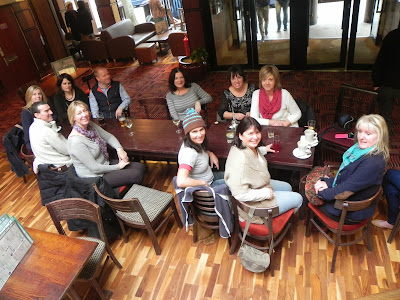The Original Photograph, Clare Terrace School Butlins trip, 1977
The New Photograph, Past Clare Terrace School Pupils, 2013
INTENTIONS
Whilst exploring the idea of
re-creating the photograph of the Clare Terrace School children in 1977, I soon
realised the many layers and potential outcomes it was capable of creating.
Motivated by the ‘The Way We Were’ section in The Falmouth Packet Newspaper, my
interest surrounding a loss of community, led me to this photograph
re-creation. My initial intentions for this project, were to bring together a community,
so that they could be reminded of how good it feels to be a part of a social
group. I intended to use the photo-recreation as a platform for social
interaction and I was pleasantly surprised with the enthusiastic response I
received, from the majority. Although I was aware that this could prove a
positive experience for the small community involved, my own intentions were
focused on disseminating my message amongst the far larger, social sphere. I
planned to do this by getting the image into the newspaper, advertising the
event over the radio, posting the project on my online blog, as well as
eventually exhibiting it in a gallery setting.
TRACKING DOWN THE PEOPLE
When attempting to track down
the people from the image, I approached it in various ways, such as phone
calls, texts, e-mails, letters, Facebook, face to face contact, radio call-outs
and I also placed an advert in the Newspaper. For me, I felt this instantly
brought an interesting aspect to the project, as there was something quite
curious about how difficult it was to get in touch with people. Despite living
in a society fuelled by technology and social networking sites, many people
from this image were not connected at all. As a consequence, this presented me
with a difficult challenge, but the method of researching and locating people,
by as many means possible, appealed to me in some way.
THE UNEXPECTED MICRO-COMMUNITY
OF KNITTERS
Another aspect, which emerged
during the development of this project, was the micro-community of knitters. To
begin with, I managed to get in touch with five, local ladies (two of which
were Mothers of the people in the original image), who were all keen to help. I
soon found myself collaborating with these ladies, to complete over 20 wooly
hats in the original school colours, complete with pom poms. Then, on the day
of the photo-recreation, I discovered that two more of the original Mothers had
knitted their daughters hats, just like they did in 1977. At this point, the process of making the hats,
had become an important factor to my project. The knitting had acted as another
platform for social interaction and conversation, as I met and shared skills
with new people.
Also on the day of the
photograph, it was great to see that the hand-knitted bobble hats acted as a
sort of leveller and broke down barriers. The participants instantly seemed
relaxed around each other, as the hats were an amusing topic of conversation.
THE PHOTOGRAPH – FORM
I wanted to position the
people in the image to place emphasis on the missing people. The reason being,
I decided that the final photograph needed to reflect a decaying community.
Although I had initially intended to print the final image in colour, I decided
that it was important to draw the viewers’ attention solely to the comparison
of images and the missing people, rather than being distracted by the new
coloured photograph. I also printed the image as close to the original size as
possible, for the same reason. Additionally,
I had considered bringing a sort of, artificial aspect to the picture by
placing the people in an inappropriate context, on a sheet of fake grass, as I
felt this would reflect the ‘set up’ and almost forced nature of the event.
However, once I began taking the photographs, I soon decided that I did not
need this, as I felt it would also detract from the comparison between the old
and new images. Analysing the final photograph, I think there is something that
really works, especially when presented next to the original image. I feel the
gaps and missing people, successfully translate the idea of a diminishing
community. Though, I would have liked to have perfected the positioning of a
couple of the people who were slightly in the wrong position. However, when
dealing with a group of people who had not seen each other for 36 years, it was
difficult to direct them otherwise.
DOCUMENTATION
I have realised that my desire
to get this image into the newspaper offers an entirely new dimension to my
project. Not only is it preserving this experience back into the newspaper,
just like it was in 1977, but my work now exits for a secondary audience,
beyond the very small community that was present on the day of the photograph.
Although the participants have experienced the event in real-time, by
documenting it into the newspaper, the potential audience has increased. This
also applies to the various other ways I have attempted to get my work out into
the wider, cultural realm (radio, online presence etc). This, then brings me to my considerations
regarding presenting my documentation in a gallery setting. I have previously
exhibited my socially-engaged work solely in the public realm, however, I have
come to realise that despite the societal nature of my practice, it does not
mean, my art would not benefit from being displayed in the context of a
gallery. I feel that, if anything, it will provide another avenue for my work to
reach more people.
I am extremely pleased and overwhelmed
with the outcome of this project and am inspired to continue working in the
realm of socially-engaged/relational work. I intend to take aspects of this
project and develop them in the hope for another successful, community project.
Below: Photographs from after the event.





















